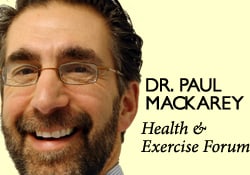
HIP & KNEE REPLACEMENT UPDATES: IMPORTANT NEW OPTIONS AVAILABLE
This column is a monthly feature of “Health & Exercise Forum” in association with the students and faculty of Geisinger Commonwealth School of Medicine.

There is good news for those in need of a hip or knee replacement today! Recent advances have ushered in a new era of joint replacement for patients in Northeastern Pennsylvania.
Recent studies conclude that hip and knee replacement surgery has had a very positive impact on lifestyle and overall health benefits for more than 7 million people in the United States that have had a hip or knee joint replaced. In view of this, it is predicted that this number will increase substantially with the aging baby boomer population.
Health & Exercise Forum will dedicate the next three weeks to the topic of “Hip and Knee Replacement Updates.” Part I will discuss hip and knee arthritis and treatment options, including knee replacement. Part II will offer a self-assessment to determine if you are ready or eligible for a new hip or knee. Part III will present the benefits and complications of a new hip or knee and will specifically discuss a new option in hip and knee replacement surgery – MAKO Robotic Assisted Joint Replacement.
ARTHRITIS OF THE HIP OR KNEE
I have been advising my patients to exercise, keep active, and walk as long as they can in order to stay mobile and healthy. However, seniors often tell me activities that require prolonged walking are limited by hip or knee pain from arthritis. They often ask, “What is arthritis?” How does it happen? What can I do about it? I will attempt to answer these questions, however, keep in mind that having hip or knee joint arthritis is not a death sentence to an active lifestyle.
Your family physician will examine your knee to determine if you have arthritis. In more advanced cases you may be referred to an orthopedic surgeon or rheumatologist for further examination and treatment. X-rays will show if the joint space between the bones in the joint is getting narrow from wear and tear arthritis. If rheumatoid arthritis is suspected, blood tests and an MRI may be ordered. The diagnosis will determine if your problem is mild, moderate or severe.
In the early stages, your treatment will be a conservative, nonsurgical approach, which may include; anti-inflammatory medication, orthopedic physical therapy, exercise, activity modifications, supplements, bracing, etc. You along with your family physician, orthopedic surgeon or rheumatologist will decide which choices are best.
John J Mercuri, MD, MA; Orthopedic Surgeon at Geisinger Orthopedics and Sports Medicine in Scranton, recommends the Clinical Practice Guidelines from the American Academy of Orthopedic Surgeons (AAOS) for interventions based on the supporting literature for treatment efficacy:
The following interventions, while often used and may not be harmful, are NOT supported in the literature for treatment efficacy:
When conservative measures no longer succeed in controlling pain and deformity or improving strength and function, then more aggressive treatment may be necessary.
SOURCES: Rothman Institute, Philadelphia, PA; American Academy of Orthopaedic Surgeons (AAOS), Stryker Corporation, Geisinger Orthopedics and Sports Medicine
For More Information: aaos.com; stryker.com; YouTube: “MAKO Robotic Joint Replacement.”
Medical Contributor: John J Mercuri, MD, MA; Orthopedic Surgery - Adult Reconstruction; Geisinger Orthopaedics and Sports Medicine; Clinical Assistant Professor at Geisinger Commonwealth School of Medicine
Visit your doctor regularly and listen to your body.
NEXT MONDAY – Read Dr. Paul J. Mackarey “Health & Exercise Forum!” Next Week: Part II of III on “Hip & Knee Replacement Updates.”
This article is not intended as a substitute for medical treatment. If you have questions related to your medical condition, please contact your family physician. For further inquires related to this topic email: drpmackarey@msn.com
Paul J. Mackarey PT, DHSc, OCS is a Doctor in Health Sciences specializing in orthopaedic and sports physical therapy. Dr. Mackarey is in private practice and is an associate professor of clinical medicine at GCSOM.